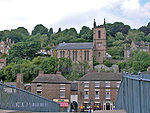Broseley Pipeworks
History of ShropshireIndustrial archaeological sites in EnglandIndustry museums in EnglandIronbridge Gorge Museum TrustMuseums in Shropshire ... and 3 more
Pipe makersUnited Kingdom museum stubsUse British English from January 2017

The Broseley Pipeworks is one of ten Ironbridge Gorge Museums administered by the Ironbridge Gorge Museum Trust. The museum is based in the small town of Broseley in the Ironbridge Gorge, in Shropshire, England within a World Heritage Site, acclaimed as the birthplace of the Industrial Revolution. Once the site of the most prolific clay tobacco pipe makers in Britain, exporting worldwide, the works were abandoned in the 1950s. The museum preserves the details of the industry of clay tobacco pipe making and has a display of clay tobacco pipes, including the Churchwarden and Dutch Long Straw pipes.The pipeworks are Grade II listed.
Excerpt from the Wikipedia article Broseley Pipeworks (License: CC BY-SA 3.0, Authors, Images).Broseley Pipeworks
King Street,
Geographical coordinates (GPS) Address Nearby Places Show on map
Geographical coordinates (GPS)
| Latitude | Longitude |
|---|---|
| N 52.61685 ° | E -2.48657 ° |
Address
King Street
King Street
TF12 5PN
England, United Kingdom
Open on Google Maps










